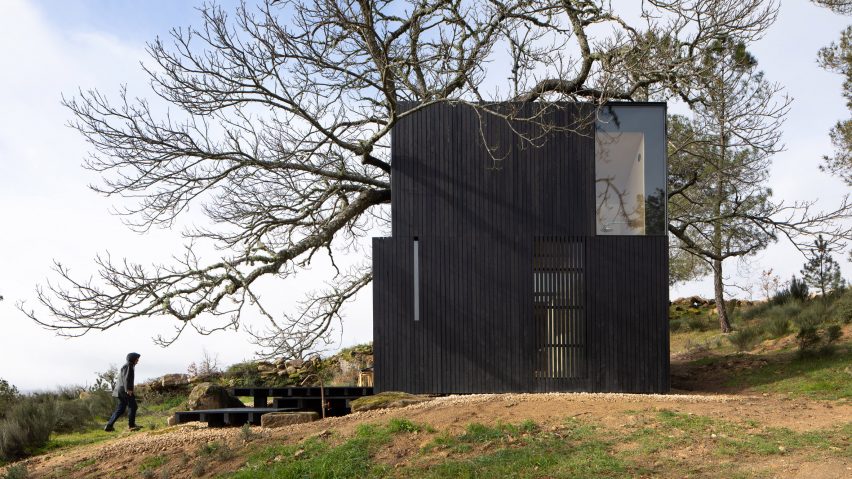Angled glass walls frame close-up views of a mature tree at the centre of the Chestnut House in Vale Flor, Portugal, designed by local architect João Mendes Ribeiro.
Clad in black-painted timber and lined with plywood panels, the dwelling is designed by Ribeiro as an "elegant shelter" in the rural landscape.
Chestnut House is one of five projects shortlisted in the small building category of Dezeen Awards 2022.
According to the architect, the idea for its design started "from the idea of the place".
"The reference to 'genius loci' summarises the design starting point: the place and the large century-old chestnut tree," Ribeiro said.
"The main idea of the project was to shift interest from the architectural object to the place and site, so that the context is the starting point of the project."
Inside the 25-square-metre volume, a living area, kitchen and sleeping space all occupy one room arranged around a central freestanding fireplace.
Along the eastern edge, the walls of this space have been angled inwards to hug the existing chestnut tree, which now stands between the home and a wooden decked terrace.
Full-height windows frame a view of the tree's trunk in the living area, creating a close connection between the interior and the landscape that will change throughout the year.
"The geometry [of the home] is broken and tensioned by the tree trunk and its branches, opening the building towards the tree canopy," said Ribeiro.
"The house reveals throughout the year the changes of the seasons and weather," the architect added. "It is the changing game of nature that determines the life of the inhabitant."
At the southern end of the Chestnut House, a wooden ladder leads up to a small mezzanine level providing room for an additional bed, while to the north is a bathroom.
A sloping butterfly-style roof rises at either end of the home, where large windows illuminate the bathroom and provide the mezzanine area with expansive views of the landscape.
Chestnut House was built using a wooden structure, lined with oriented strand board (OSB) and cork panels for thermal and acoustic insulation.
Internal walls, ceilings and furniture are all finished with plywood panels that bring a "warm and welcoming" atmosphere to the interior, while minimal fittings help to focus attention towards the outdoors.
Many architects look to minimise their impact on natural sites by incorporating existing trees into their designs. In Brazil, Luciano Basso created an elevated concrete home around a pine tree while in Australia, Alexander Symes designed an extension with a terrace perched in a tree canopy.
The photography is by José Campos.

